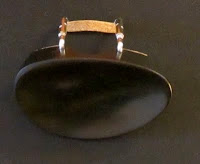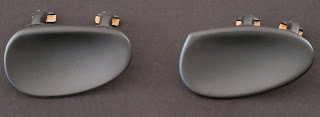Written by Andy Fein, luthier at Fein Violins
and Angie Newgren
When purchasing a violin, usually you play on a few different instruments before choosing the correct one for you. The same can go for chin rests! There are many different structures of faces around the world so there are also different options for chin rests. You do not necessarily need to stick with the one that came with your violin. In fact, if the chin rest on your instrument is not comfortable, change it!
A tremendous variety of chin rests are made for violin and viola. Some hold your chin on the left of the instrument and some on the center. Some have deeper arcs, some are close to flat. You should choose your chin rest the same way you choose your instrument. Somehow, you need to fill the space between your chin and your shoulder. It's best to do it in the most comfortable way possible.
Here's a simple idea that's sometimes hard to accomplish: You should be able to hold your violin or viola up in playing position without straining and without using your left hand to support your instrument. AND- without clenching your jaw! Your chin rest, along with your shoulder rest, is an important component of accomplishing that.
Our shop carries multiple kinds of chin rests for all sized violins and violas.They are made from rosewood, ebony, boxwood, and even hypo-allergenic composite material.
Here are some photos of different chin rests we have here in the shop. Note the different ways they can be set on your violin, and the different ways they would feel under your chin.
Ebony chin rests:
Boxwood chin rests:
Rosewood chin rests:
Centered chin rests made of ebony:
The Guarnerius model chin rest is the most common (the chin bed lies to the left of the tailpiece, while the part that attaches to the instrument goes over the tailpiece. It is usually longer and flatter than other styles)
Here is how the three different styles of chin rests (side mount, Guarnerius model, and center mount) look on the instrument:
When customers come into our shop and tell us their chin rest is not comfortable, we first put on the Wittner chin rest to try out. The Wittner side mounted chin rest is a wonderful alternative for many people. They are very smoothly shaped, have no sharp edges, are well contoured to a chin's curves and are from a hypo-allergenic composite material.
If you get a violin "hickey" from your chin rest, it's often due to an allergy to the nickel in the chin rest hardware. The Wittner chin rests do not have any metal touching your skin so this is a good alternative for that reason as well.
The center-mounted Wittner chin rest is pictured on the left, the side-mounted Wittner chin rest is pictured on the right.
If your chin rest doesn't work, there are many models to go through. The slightest variation to a chin rest can make a large difference to your comfort. Part of the process, however, is to put the chin rest on, try it while you are playing, and then take it off and try a different style of chin rest. Time consuming, but well worth the effort.
Your chin rest and shoulder rest work as a team to keep you in the best playing position. Amy has written a great blog on playing without hurting yourself.
and Angie Newgren
When purchasing a violin, usually you play on a few different instruments before choosing the correct one for you. The same can go for chin rests! There are many different structures of faces around the world so there are also different options for chin rests. You do not necessarily need to stick with the one that came with your violin. In fact, if the chin rest on your instrument is not comfortable, change it!
A tremendous variety of chin rests are made for violin and viola. Some hold your chin on the left of the instrument and some on the center. Some have deeper arcs, some are close to flat. You should choose your chin rest the same way you choose your instrument. Somehow, you need to fill the space between your chin and your shoulder. It's best to do it in the most comfortable way possible.
Here's a simple idea that's sometimes hard to accomplish: You should be able to hold your violin or viola up in playing position without straining and without using your left hand to support your instrument. AND- without clenching your jaw! Your chin rest, along with your shoulder rest, is an important component of accomplishing that.
Our shop carries multiple kinds of chin rests for all sized violins and violas.They are made from rosewood, ebony, boxwood, and even hypo-allergenic composite material.
Here are some photos of different chin rests we have here in the shop. Note the different ways they can be set on your violin, and the different ways they would feel under your chin.
Ebony chin rests:
Boxwood chin rests:
Rosewood chin rests:
Centered chin rests made of ebony:
The Guarnerius model chin rest is the most common (the chin bed lies to the left of the tailpiece, while the part that attaches to the instrument goes over the tailpiece. It is usually longer and flatter than other styles)
 |
| Guarnerius model chin rest in Ebony |
 |
| Side mounted chin rest, Guarnerius model chin rest, and center mounted chin rest |
When customers come into our shop and tell us their chin rest is not comfortable, we first put on the Wittner chin rest to try out. The Wittner side mounted chin rest is a wonderful alternative for many people. They are very smoothly shaped, have no sharp edges, are well contoured to a chin's curves and are from a hypo-allergenic composite material.
If you get a violin "hickey" from your chin rest, it's often due to an allergy to the nickel in the chin rest hardware. The Wittner chin rests do not have any metal touching your skin so this is a good alternative for that reason as well.
The center-mounted Wittner chin rest is pictured on the left, the side-mounted Wittner chin rest is pictured on the right.
If your chin rest doesn't work, there are many models to go through. The slightest variation to a chin rest can make a large difference to your comfort. Part of the process, however, is to put the chin rest on, try it while you are playing, and then take it off and try a different style of chin rest. Time consuming, but well worth the effort.
 |
| Joshua Bell with a centered chin rest |











Such great info. I've tried several different chin rests for my violin and viola. I finally settled on one that is centered on the instrument. If I played more I'd definitely try the Wittner model. Maybe it will be incentive to play more....
ReplyDeleteThis article may be the solution for my many years with chin rest problems. None of them seem to fit right...giving me jaw pain and or weariness on my shoulder.
ReplyDeleteBy just looking at them it seems like the Guarnerius or the Kreisler/Bergonzi type may be the ones indicated for me....I guess I have to continue trying them.....
I feel the same as Tito, with the added pressure of feeling my job is in jeopardy if I dont find the right or semi right set up and SOON!!!!!!!!!!! I just ordered one called "London" 90 percent of guarneris I have tried do not work for me, partly because of my instrument and partly because of me. My viola has a sharp lip along the purfling that descends and ascends sharply playing havoc with most chinrests
ReplyDeleteI need the smaller chinrest possible, the one that allow me to rest my neck and chin down, instead of tenseing and lifting it. Most of types are the same, the mayority lead your neck and chin to be partially rised, not good for me. I've been trying to remember or find a spacific tye that I tryed once, it was very smal and simple, if anyone has a name for smaller types of chinrest, I will really appreciate it.
ReplyDelete